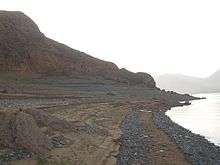Liujiaxia Dam
The Liujiaxia Dam (simplified Chinese: 刘家峡大坝; traditional Chinese: 劉家峽大壩; pinyin: Liújiāxiá Dàbà) is a major hydroelectric dam on the upper Yellow River, in Linxia Hui Autonomous Prefecture of China's Gansu Province. The dam and its hydroelectric facility (Liujiaxia Hydroelectric Station, simplified Chinese: 刘家峡水电站; traditional Chinese: 劉家峽水電站; pinyin: Liújiāxiá Shuǐdiàn Zhàn) are located in Liujia Gorge, or Liujiaxia (literally, "Liu Family's Gorge"), just downstream from where the Tao River flows into the Yellow River. The site is on the eastern outskirts of Liujiaxia Town. Since Liujiaxia Town is the county seat of Yongjing County, it is often marked on less detailed maps simply as "Yongjing".
| Liujiaxia Dam | |
|---|---|
 | |
| Official name | 刘家峡大坝 |
| Coordinates | 35°56′02″N 103°20′34″E |
| Construction began | 1958 |
| Opening date | 1969 |
| Dam and spillways | |
| Type of dam | Gravity dam |
| Impounds | Yellow River |
| Height | 147 m (482 ft) |
| Length | 840 m (2,756 ft) |
| Width (base) | 16 m (52 ft) |
| Reservoir | |
| Creates | Liujiaxia Reservoir |
| Total capacity | 4.24 km3 (1 cu mi) |
| Power Station | |
| Turbines | 3 × 225MW,1 × 250MW,1 × 300MW |
| Installed capacity | 1,225 MW |
The Liujiaxia Reservoir (simplified Chinese: 刘家峡水库; traditional Chinese: 劉家峽水庫; pinyin: Liújiāxiá Shuǐkù) formed by the dam is the largest body of water within Gansu. The primary purpose of the dam is generating electricity; in addition, it is used for flood control, irrigation, and "ice flood prevention".[1] The dam's location is about 70 km (43 mi) west-south-west (or 100 km (62 mi) upstream[1]) from the provincial capital Lanzhou.
Liujiaxia Dam is a concrete gravity dam 147 m (482 ft) high and 16 m (52 ft) wide on top. The main section of the dam is 204 m (669 ft) long; including auxiliary sections on both sides, the length totals 840 m (2,756 ft).[1][2]
The power plant has 5 generators with the total installed capacity of 1,225 MW.[1][2] When it became fully operational in 1974, it became the country's largest hydroelectric power plant, and remained so until the 1980s.[3]
History

In 1955, just a few years after the creation of the People's Republic of China, the Communist government announced a large-scale program of hydroelectric dam construction on the Yellow River.[4] According to the plan, a dam was to be built in each of the Three Gorges of the Yellow River: Liujia Gorge, Yanguo Gorge, and Bapan Gorge. The detailed geological investigation of the area, to choose the most suitable site for the dams, started immediately.[1]
In 1958 construction work started on the first two dams, both located in Linxia Hui Autonomous Prefecture's Yongjing County: the 57-meter high Yanguoxia Dam (in Yangou Gorge, downstream from Liujiaxia) and the 147-meter high Liujiaxia Dam in Liujia Gorge.[4] While the smaller Yanguoxia Dam was completed in 1961,[4] the work on Liujiaxia Dam itself was suspended in 1961-63,[1] and the dam itself was only completed in 1969.[4] The five generators were brought into service, one after another, between 1969 and 1974.[5]
Hu Jintao, then a young engineer, joined the project's staff in 1968.[2] Guo Moruo visited the site in 1971 and wrote a poem on the occasion.[2][6]
The reservoirs created by the three-dam cascade (also including Bapanxia Dam (1968-1975) farther downstream) displaced a large number of local farmers. The three reservoirs flooded 118,229 (7,881 hectares) of farmland and displaced 43,829 residents, primarily in Yongjing County.[4] The compensation payments to the farmers affected by the Liujiaxia Dams reportedly averaged 364 yuan per person (but in reality may have been even lower), and were grossly inadequate.[4] It is said that the residents received lower compensation amount than they could otherwise because in 1958, during the Great Leap Forward, when the Yanguoxia project started, they understated the value of their assets, as they were afraid to be classified as "rich peasants", i.e. class enemies.[7]
References
- International Association of Engineering Geology (1986). Proceedings, Fifth International Congress, International Association of Engineering Geology, International Association of Engineering Geology. 2. Taylor & Francis. pp. 1225–1228. ISBN 90-6191-662-3.
- "临夏旅游" (Linxia Tourism), published by Linxia Hui Autonomous Prefecture Tourist Board, 2003. 146 pages. No ISBN. Pages 26=27.
- Jun Jing (1998). The Temple of Memories: History, Power, and Morality in a Chinese Village. Stanford University Press. pp. 25–27. ISBN 0-8047-2757-0.
- Jun Jing (1998), pp. 71-73
- 刘家峡水电站 (Liujiaxia Hydroelectric Plant), at baidu.com
- 郭沫若咏《满江红》肖华赋五律 咏赞刘家峡 Archived 2011-07-19 at the Wayback Machine (Go Moruo's "A trip to Liujiuxia", rhymed on the Man Jiang Hong pattern.)
- Jun Jing (1998), pp. 76-77